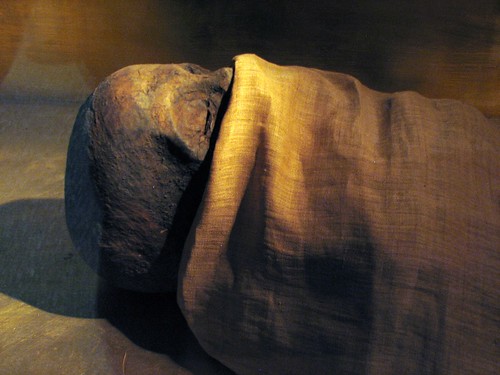 First they perfected chocolate, then the penknife. Now the Swiss are seeking to unlock the mysteries of mummification.
First they perfected chocolate, then the penknife. Now the Swiss are seeking to unlock the mysteries of mummification.
According to a recent article in The Journal of Turkish Weekly (“Swiss Research Unlocks Mummy Secrets”), A leading Swiss anatomy expert has managed to mummify a body part using the same salt drying process the ancient Egyptians employed. Frank Rhli, head of the Zurich University Institute of Anatomy, is attempting to mummify a human leg. Having participated in the CT scan analysis of Tutankhamun and the tzi iceman, Rhli is no stranger to mummies.
So far the Swiss team has met with mixed results. After 440lbs (60kg) of salt mixture and 80 days, magnetic resonance still shows signs of moisture within the tissue. Dr. Rhli had expected the process to take around 70 days, and plans to continue for another month. Sometime this winter the team will attempt to mummify another body part, this time accounting for the role heat plays in mummification.
The article states that the Swiss team is basing their salt mixture on a mid-1990s United States study, which tried to determine the magic formula used by ancient Egyptians to dry out bodies before burial, but the details of the U.S. study are not given.
In 1994, Ronn Wade, the Director of Anatomical Services at the University of Maryland Medical School in Baltimore, and Bob Brier, an Egyptologist at the C. W. Post Campus of Long Island University, successfully mummified an entire human body using the tools and methods that would have been (to our best knowledge) used by the ancient Egyptians.
The salt mixture Wade and Brier used was natron, a naturally occurring compound consisting of sodium chloride, sodium sulfate, sodium carbonate, and sodium bicarbonate. Natron is commonly found along the Nile River and is known for both its desiccating and antibacterial properties, both vital to the mummification process. They used a total of 600lbs (272kg) of natron for an entire body. It is likely that the Swiss study is using the formula employed by Wade and Brier.
Rhli will also be examining how much the mummification process degrades DNA, which may have implications for Egypts Supreme Council of Antiquities efforts to produce a genetic map of the Eighteenth Dynasty. Dr. Zahi Hawass has predicted that this year will see the identification of various members of Tutankhamuns family, including his parents, Nefertiti, and other New Kingdom mummies. The Swiss teams studies could cast possible doubts on the reliability of these tests.
Frank Rhli says he would eventually like to attempt to mummify an entire human body using the same process he is currently trying to perfect. While his interest as an anatomist is obvious, he also has sociological and anthropological questions. “I’m medically interested in how tissue reacts, he states, but I’m historically interested to know how ancient cultures tried to preserve their loved ones after death.”
Image by bswiz. All rights reserved.


